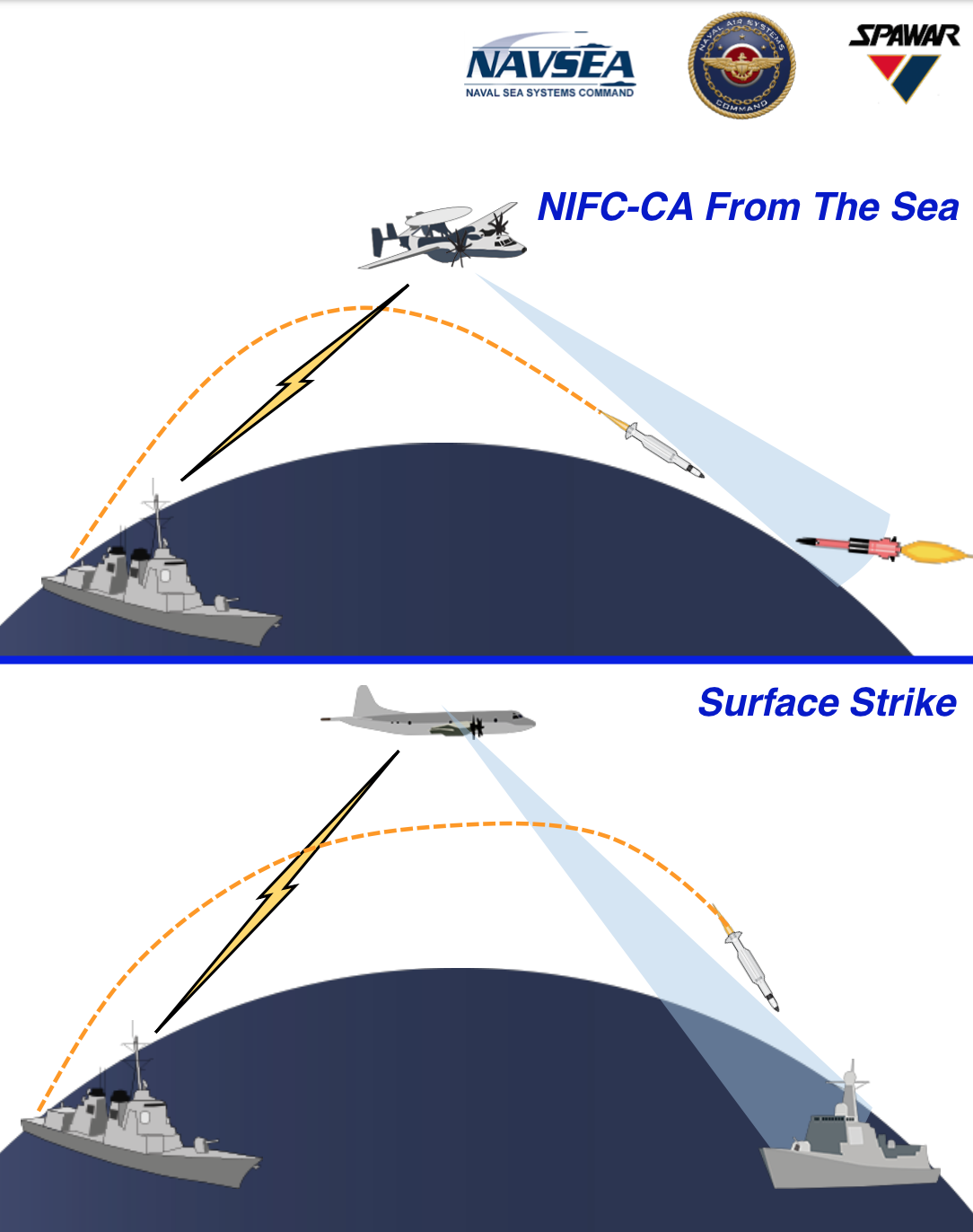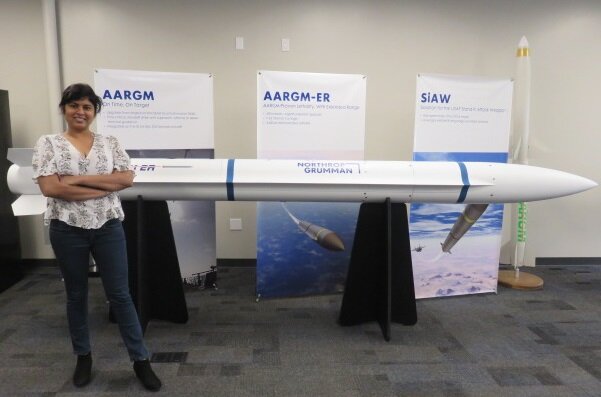The question as always is how you provide relevant up to second target data for the SM-2/SM-6 to get them within the limited range of their narrow band seekers to lock on to the enemy ship moving at say 20 knots beyond line of sight. The above graphic looks pure fantasy eg if your target is say a Chinese Type 055 or Type 052 destroyers equipped with their equivalent to the SM-6, the HQ-9, expect both the slow moving a/c with no stealth capability, E-2 and P-8, would be easy targets fot the HQ-9 as would Chinese similar a/c for the SM-6.Isn't that exactly the trajectory like?I would think SM-6 likely doesn’t have the same trajectory as SM-1. SM-1 AFAIK was SARH all the way. A missile brought onto its target with mid course updates and/or an INS guidance phase should be able to arrive almost directly over its target and tip over like a Kh-22. I don’t know that is the case but I don’t see why such a flight profile would be more than a software change, and it would have a couple advantages in terms of terminal effect and defenses. I think the SAM mode is similar - a long fairly flat run out after a high lofted trajectory and then a dive onto the target. For a surface target that effectively has no motion, I don’t see why the terminal dive couldn’t be as steep as the missile body could sustain.

You are using an out of date browser. It may not display this or other websites correctly.
You should upgrade or use an alternative browser.
You should upgrade or use an alternative browser.
DARPA Long Range Anti-ship Missile (LRASM)
- Thread starter bobbymike
- Start date
Maybe that why they integrated F-35 into the chain?The question as always is how you provide relevant up to second target data for the SM-2/SM-6 to get them within the limited range of their narrow band seekers to lock on to the enemy ship moving at say 20 knots beyond line of sight. The above graphic looks pure fantasy eg if your target is say a Chinese Type 055 or Type 052 destroyers equipped with their equivalent to the SM-6, the HQ-9, expect both the slow moving a/c with no stealth capability, E-2 and P-8, would be easy targets fot the HQ-9 as would Chinese similar a/c for the SM-6.
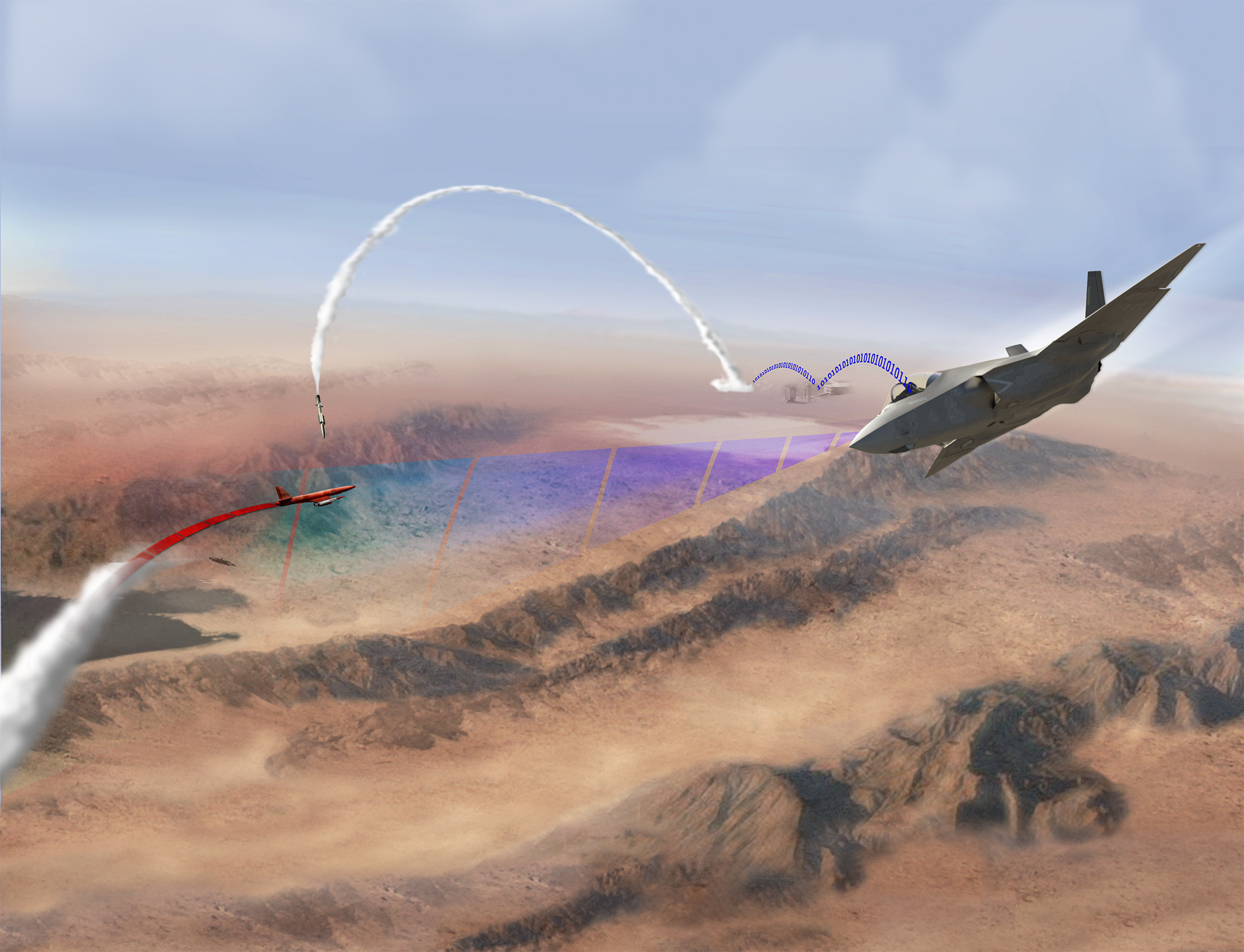
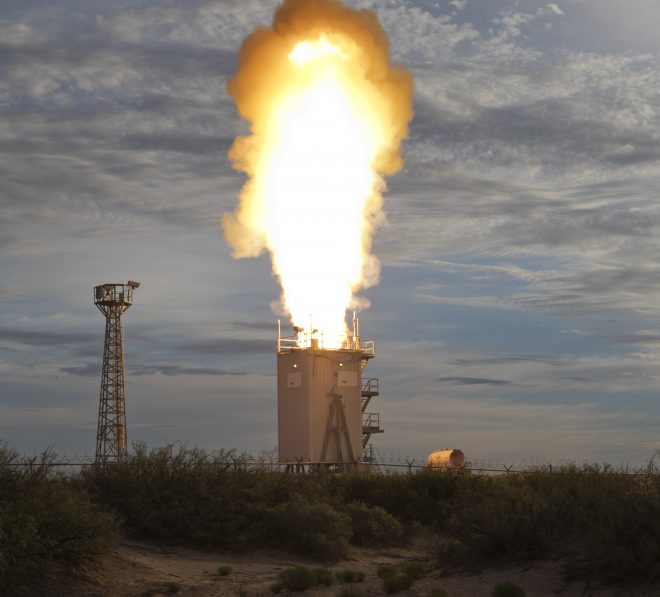
F-35, SM-6 Live Fire Test Points to Expansion in Networked Naval Warfare
An F-35 test with an Aegis Combat System armed with a SM-6 is the latest step how the Navy and Marine Corps will share data on future battlefields.
for air launched version, the speed and velocity of missile will improved a lot, so datalink might not be needed while attacking surface ship
Let say the distance is 450 km, if the average speed of missile is Mach 3.5 then it only takes 6.24 minutes till impact
if the average speed of missile is Mach 4 then it only takes 5.4 minutes till impact
Within that amount of time, a destroyer like Type 055D can travel about 5 km at most, RCS of a destroyer would be somewhere between 1000-10000 m2 so I think the missile seeker can still detect the destroyer at that distance.
My understanding is that it accepts mid course guidance updates like it would in surface to air mode but that terminal guidance comes from the active radar seeker head. SM-6, unlike most of the SM-2 family, uses active homing not SARH.
Edit: SM-6 might have an additional SARH mode; I think ESSM block 2 does. But presumably you would just use an SM-2 if you had line of site to the target.
I think SARH mode is used in conjunction with ARH, whenever the engagement profile permits.
A pure ARH missile has to devote several valuable seconds for airspace scanning before it locks onto a target, which reduces its probability of hit. With a SARH-ARH combo, the missile would've already been locked onto target under SARH and will achieve an instantaneous lock when switching over to ARH.
The question as always is how you provide relevant up to second target data for the SM-2/SM-6 to get them within the limited range of their narrow band seekers to lock on to the enemy ship moving at say 20 knots beyond line of sight. The above graphic looks pure fantasy eg if your target is say a Chinese Type 055 or Type 052 destroyers equipped with their equivalent to the SM-6, the HQ-9, expect both the slow moving a/c with no stealth capability, E-2 and P-8, would be easy targets fot the HQ-9 as would Chinese similar a/c for the SM-6.Isn't that exactly the trajectory like?I would think SM-6 likely doesn’t have the same trajectory as SM-1. SM-1 AFAIK was SARH all the way. A missile brought onto its target with mid course updates and/or an INS guidance phase should be able to arrive almost directly over its target and tip over like a Kh-22. I don’t know that is the case but I don’t see why such a flight profile would be more than a software change, and it would have a couple advantages in terms of terminal effect and defenses. I think the SAM mode is similar - a long fairly flat run out after a high lofted trajectory and then a dive onto the target. For a surface target that effectively has no motion, I don’t see why the terminal dive couldn’t be as steep as the missile body could sustain.

I think the range at which an E-2 or MQ-4C Triton can track a Type 052D or Type 055 well exceeds the max range of HQ-9, which at its most optimistic estimate is about 250km.
Without CAP or ground launched support aircraft these ships are quite vulnerable in the above scenario.
Maybe that why they integrated F-35 into the chain?The question as always is how you provide relevant up to second target data for the SM-2/SM-6 to get them within the limited range of their narrow band seekers to lock on to the enemy ship moving at say 20 knots beyond line of sight. The above graphic looks pure fantasy eg if your target is say a Chinese Type 055 or Type 052 destroyers equipped with their equivalent to the SM-6, the HQ-9, expect both the slow moving a/c with no stealth capability, E-2 and P-8, would be easy targets fot the HQ-9 as would Chinese similar a/c for the SM-6.


F-35, SM-6 Live Fire Test Points to Expansion in Networked Naval Warfare
An F-35 test with an Aegis Combat System armed with a SM-6 is the latest step how the Navy and Marine Corps will share data on future battlefields.news.usni.org
for air launched version, the speed and velocity of missile will improved a lot, so datalink might not be needed while attacking surface ship
Let say the distance is 450 km, if the average speed of missile is Mach 3.5 then it only takes 6.24 minutes till impact
if the average speed of missile is Mach 4 then it only takes 5.4 minutes till impact
Within that amount of time, a destroyer like Type 055D can travel about 5 km at most, RCS of a destroyer would be somewhere between 1000-10000 m2 so I think the missile seeker can still detect the destroyer at that distance.
Possible, that's assuming future Block 4 a/c include the wide-area high-resolution synthetic aperture radar (SAR) mode to the NG APG-81 radar. 'Big SAR' capability in Block 4 wish list, USN wants to prioritize the requirement, though yet to be confirmed if big SAR included, big SAR should be able to produce high-definition radar imagery that covers a large area on the ground/sea in one image to enhance the F-35's reconnaissance and targeting capabilities.
Also to be remembered the Chinese destroyers include low waveband radars specifically to track F-22/F-35 stealth sized a/c, low waveband radars not that accurate, approx one kilometer box, but will then use its higher band radars to concentrate on that box to enable accurate enough guidance to bring its HQ-9 seeker within range.
PS 'bring_it_on' mentioned recently "ARTS V-4 has been indefinitely suspended by the USAF. Instead, the Air Force Red-Team has launched a new effort to rapidly develop and field UHF and VHF band AESA radars over the next 3-5 years"
Would note rocket motor normally burns for 7-10 secs and then missile coasts to target so expect average speed lower than Mach 3.5 / 4 over 450 km? which will extend time which will create a much larger basket area that enemy ship will be in, decreases the possibility the seeker will be able to lock on to target eg Type 055. The fog of war, another concern at these long ranges how would radar differentiate between a Chinese navy ship and merchant or large fishing ship (have seen mention Chinese have over 10,000 in fishing fleet which expect fair number larger ships ~5,000t+)
OTH anti ship missiles always suffer from the problem of timely data updates, assuming they can even accept an update. In the 1980s the US had an anti-ship version of tomahawk which proved their eternal optimism; the flight time time to max range was well in excess of an hour. Most radar seekers will engage most anything they find in their target basket, even if its a carnival cruise liner. It isn't a strictly USN problem, though one could argue LRASM make a big strike forward on the issue by trying to ID its target passively using ESM and IIR.
- Joined
- 3 June 2011
- Messages
- 17,867
- Reaction score
- 10,892
OTH anti ship missiles always suffer from the problem of timely data updates, assuming they can even accept an update. In the 1980s the US had an anti-ship version of tomahawk which proved their eternal optimism; the flight time time to max range was well in excess of an hour. Most radar seekers will engage most anything they find in their target basket, even if its a carnival cruise liner. It isn't a strictly USN problem, though one could argue LRASM make a big strike forward on the issue by trying to ID its target passively using ESM and IIR.
Yeah, that's a problem for a subsonic missile. Supersonic/hypersonic not so much. Also, you're assuming the target knows a missile has been launched at it.
OTH anti ship missiles always suffer from the problem of timely data updates, assuming they can even accept an update. In the 1980s the US had an anti-ship version of tomahawk which proved their eternal optimism; the flight time time to max range was well in excess of an hour. Most radar seekers will engage most anything they find in their target basket, even if its a carnival cruise liner. It isn't a strictly USN problem, though one could argue LRASM make a big strike forward on the issue by trying to ID its target passively using ESM and IIR.
Yeah, that's a problem for a subsonic missile. Supersonic/hypersonic not so much. Also, you're assuming the target knows a missile has been launched at it.
I'm assuming a target could change course for a completely unrelated reason. I doubt if you talked to anyone who handled TASMs in the 80's they would feel at all confident about the prospects of the missile hitting anything. Super sonic helps the timing problem but it doesn't solve the issue, and usually it comes with a range reduction (which indirectly also helps solve the problem).
And software. The fact that the SM-6 can probably choose what part of the ship to hit to get a mission kill, covers up for the lighter warhead.Probably not, AMRAAM seeker is designed to engage quick moving target and likely just filter the ship outThe AMRAAM seeker should be able to distinguish individual parts of a ship.
They have clearly invested in this capability and not just put it out there as an afterthought. Quite logical to expect them to have invested $$ into making enhancements and adding the targeting modes required from the guidance system to make the weapon effective. It's not like they are swapping out an AMRAAM seeker and putting it into an SM-6 without enhancements.
- Joined
- 3 June 2011
- Messages
- 17,867
- Reaction score
- 10,892
The target can't move as far during missile flight with a faster missile. This should be obvious. Also CEC allows updates.OTH anti ship missiles always suffer from the problem of timely data updates, assuming they can even accept an update. In the 1980s the US had an anti-ship version of tomahawk which proved their eternal optimism; the flight time time to max range was well in excess of an hour. Most radar seekers will engage most anything they find in their target basket, even if its a carnival cruise liner. It isn't a strictly USN problem, though one could argue LRASM make a big strike forward on the issue by trying to ID its target passively using ESM and IIR.
Yeah, that's a problem for a subsonic missile. Supersonic/hypersonic not so much. Also, you're assuming the target knows a missile has been launched at it.
I'm assuming a target could change course for a completely unrelated reason. I doubt if you talked to anyone who handled TASMs in the 80's they would feel at all confident about the prospects of the missile hitting anything. Super sonic helps the timing problem but it doesn't solve the issue, and usually it comes with a range reduction (which indirectly also helps solve the problem).
Not all Chinese destroyer have low frequency radars
Also to be remembered the Chinese destroyers include low waveband radars specifically to track F-22/F-35 stealth sized a/c, low waveband radars not that accurate, approx one kilometer box, but will then use its higher band radars to concentrate on that box to enable accurate enough guidance to bring its HQ-9 seeker within range.PS 'bring_it_on' mentioned recently "ARTS V-4 has been indefinitely suspended by the USAF. Instead, the Air Force Red-Team has launched a new effort to rapidly develop and field UHF and VHF band AESA radars over the next 3-5 years"
The most modern one Type 055 only use S-band and X-band
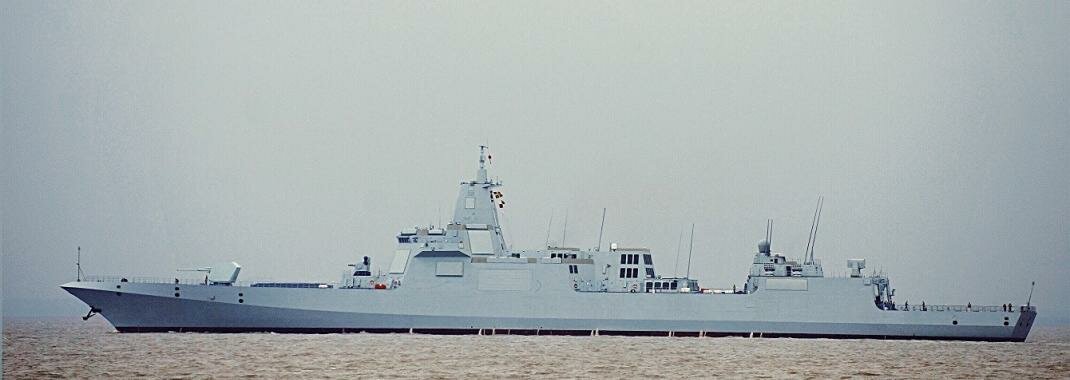
Type 52D has a VHF radar named Type-517H but it isn't a fire controlled radar, it is only a 2D search radar, so it can't even determine target height
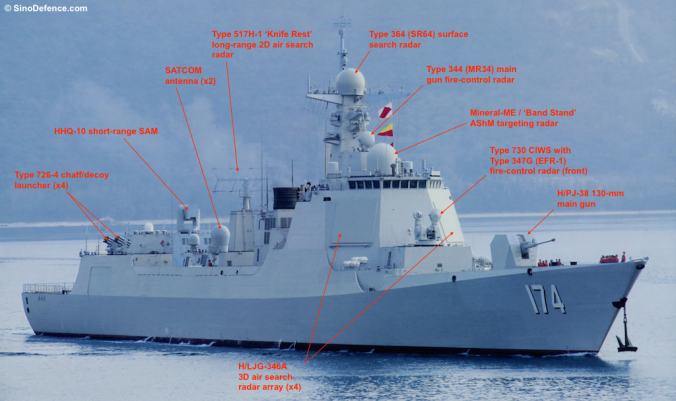
Oh and the resolution cell is much greater than 1 km, even the NEBO SVU which has aperture at least 10 times bigger than Type 517 H still has resolution cell on order of 5.5*1.6 km at 185 km.
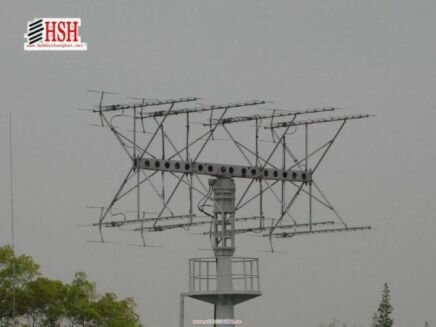
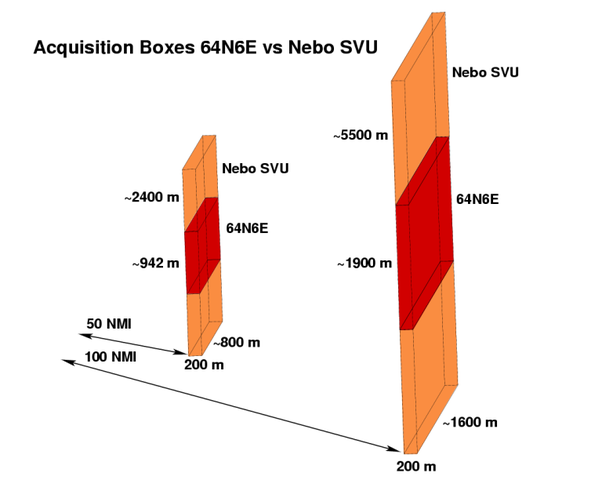
I was talking about air launched SM-6 though. When launched from high altitude, they can have much greater speed and range than the Mach 3.5 limit when launched from surface. Beside, launched from high altitude mean the missile can climb to even higher altitude and therefore reduce the impact of dragWould note rocket motor normally burns for 7-10 secs and then missile coasts to target so expect average speed lower than Mach 3.5 / 4 over 450 km
NASA
ACCESS: Restricted
- Joined
- 13 October 2020
- Messages
- 45
- Reaction score
- 111
I thought the issue of hitting the biggest target the missile saw had largely been solved with new DSP electronics and new X band seekers letting you do some level of target classification and not light up anything with the biggest return within the seeker FOV (APL was writing about this in 1980s). Harpoon and a few other missiles have been getting upgraded to support mid-course datalinks and target updates recently.OTH anti ship missiles always suffer from the problem of timely data updates, assuming they can even accept an update. In the 1980s the US had an anti-ship version of tomahawk which proved their eternal optimism; the flight time time to max range was well in excess of an hour. Most radar seekers will engage most anything they find in their target basket, even if its a carnival cruise liner. It isn't a strictly USN problem, though one could argue LRASM make a big strike forward on the issue by trying to ID its target passively using ESM and IIR.
@Ronny -Thx for your input
If the VHF search radar able to find the bearing and range of stealth attack a/c that would cue the higher band digitally controlled radars to concentrate all their power on that particular bearing with extended dwell time etc to establish height etc of target a/c for AA missile launch. If the reports emanating from China are to be believed they have recently they have made big strides in developing long waveband radars with improved discrimination to replace the Nebo SVU 2000 era radars, it would make sense for the Chinese to make long waveband R&D a priority to counter F-22 and F-35. Ref. articles from defense-aerospace, now suspended
From <http://www.defense-aerospace.com/ar...-radar-can-guide-to-hit-stealth-aircraft.html>
From <https://defense-aerospace.com/artic...awarded-for-classified,-advanced-project.html
PS Re your pic of the Type 055 intrigued as to what the two lower panels are on the lower deck house, did wonder if they were flat panel radars, ESM?
Re your point on the air launched SM-6 and how that would extend range/speed compared to a surface launched missile, but would ask how the relatively small a/c radar would be able to target a ship at 450 km / 280 miles range, would expect that range would require radar antenna size of an E-2, also if SM-6 launched from a F-35 it would be carried externally on its wings as far too big to fit in weapons bay so its stealth capabilities would near zero.
If the VHF search radar able to find the bearing and range of stealth attack a/c that would cue the higher band digitally controlled radars to concentrate all their power on that particular bearing with extended dwell time etc to establish height etc of target a/c for AA missile launch. If the reports emanating from China are to be believed they have recently they have made big strides in developing long waveband radars with improved discrimination to replace the Nebo SVU 2000 era radars, it would make sense for the Chinese to make long waveband R&D a priority to counter F-22 and F-35. Ref. articles from defense-aerospace, now suspended
From <http://www.defense-aerospace.com/ar...-radar-can-guide-to-hit-stealth-aircraft.html>
From <https://defense-aerospace.com/artic...awarded-for-classified,-advanced-project.html
PS Re your pic of the Type 055 intrigued as to what the two lower panels are on the lower deck house, did wonder if they were flat panel radars, ESM?
Re your point on the air launched SM-6 and how that would extend range/speed compared to a surface launched missile, but would ask how the relatively small a/c radar would be able to target a ship at 450 km / 280 miles range, would expect that range would require radar antenna size of an E-2, also if SM-6 launched from a F-35 it would be carried externally on its wings as far too big to fit in weapons bay so its stealth capabilities would near zero.
The JY-27A radar in that article is many many times bigger than the Type 517H radar on Type052D destroyer, since beamwidth is inversely proportional to aperture, it come at no surprise at JY-27A is many times more accurate, probably order of magnitude better@Ronny -Thx for your input
If the VHF search radar able to find the bearing and range of stealth attack a/c that would cue the higher band digitally controlled radars to concentrate all their power on that particular bearing with extended dwell time etc to establish height etc of target a/c for AA missile launch. If the reports emanating from China are to be believed they have recently they have made big strides in developing long waveband radars with improved discrimination to replace the Nebo SVU 2000 era radars, it would make sense for the Chinese to make long waveband R&D a priority to counter F-22 and F-35. Ref. articles from defense-aerospace, now suspended
From <http://www.defense-aerospace.com/ar...-radar-can-guide-to-hit-stealth-aircraft.html>
From <https://defense-aerospace.com/articles-view/release/3/208893/china's-top-radar-institute-awarded-for-classified,-advanced-project.html
Secondly, the resolution cell of Type517H is already many time bigger than the beamwidth of Type 346A X band radar, so I don't think it can improve dwell time
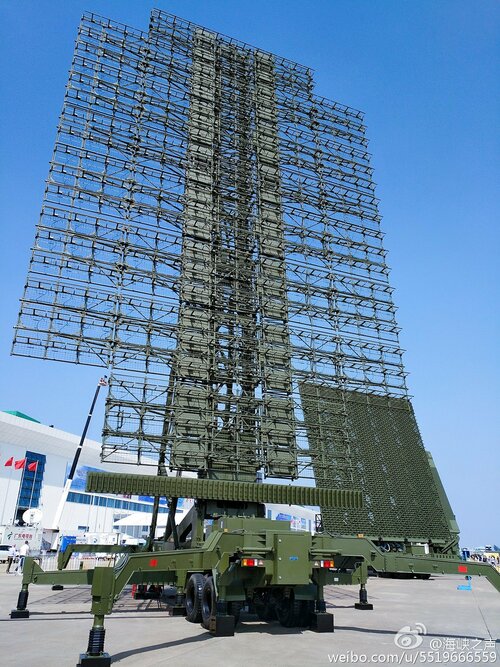
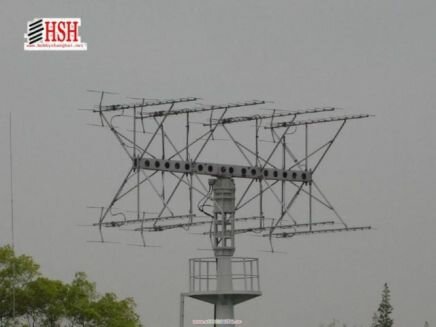
https://defense-aerospace.com/articles-view/release/3/208893/china's-top-radar-institute-awarded-for-classified,-advanced-project.html
You don't necessarily need a radar to find ship, an ESM system can also be used to locate a ship, the same way ESM system can be used to locate a SAM radar.PS Re your pic of the Type 055 intrigued as to what the two lower panels are on the lower deck house, did wonder if they were flat panel radars, ESM?
Re your point on the air launched SM-6 and how that would extend range/speed compared to a surface launched missile, but would ask how the relatively small a/c radar would be able to target a ship at 450 km / 280 miles range, would expect that range would require radar antenna size of an E-2,
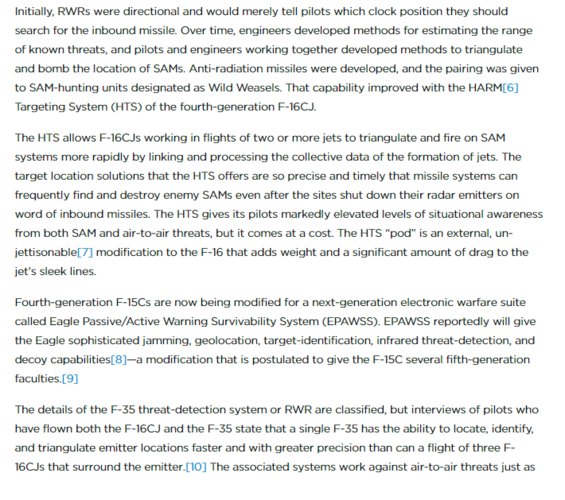
It doesn't really matter, because of radar horizon. Take Type055 for example, the highest radar mass is at around 25 meters above sea surface, so the radar horizon to an F-35 cruising at 30.000 ft is 415 km, well within range of air launched SM-6also if SM-6 launched from a F-35 it would be carried externally on its wings as far too big to fit in weapons bay so its stealth capabilities would near zero.
It can also carry 1-2 Dash-X drone in the weapon bay, after release they can climb up to sniff out the location of the destroyer and send data back to the aircraft which always remain below radar horizon
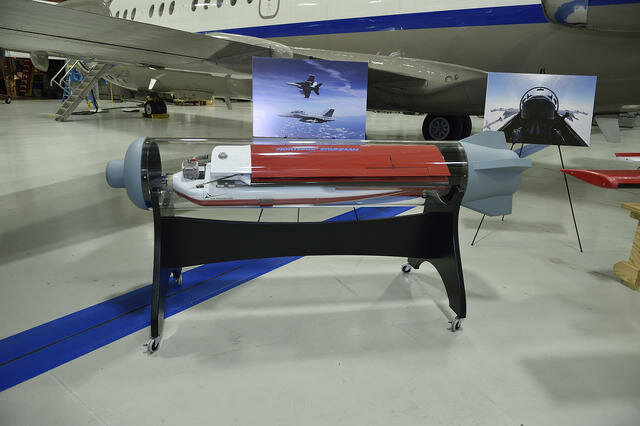
Last edited:
Detecting a large ship on the ocean is more a question of altitude, not radar power. F-35 blk4 specifically has a software upgrade for a surface search mode; I’ve no doubt it can find a large target out to the horizon. However satellites and high altitude drones would probably be more common targeting methods. Underwater sensors might also play a role.
- Joined
- 21 April 2009
- Messages
- 13,549
- Reaction score
- 7,135
aonestudio
I really should change my personal text
- Joined
- 11 March 2018
- Messages
- 2,847
- Reaction score
- 7,000
good for them LRASM is kinda a boring weapon
I think it is boring only in the sense it isn't supersonic. Its passive guidance methods are quite novel and combined with the low RCS airframe allow for an attack with very vague targeting information with a low probability of detection until the terminal sea skimming phase.
bring_it_on
I really should change my personal text
- Joined
- 4 July 2013
- Messages
- 3,231
- Reaction score
- 2,586
LRASM is a great capability. Besides the DARPA developed seeker (which folks just take for granted), its most important feature is that it is available and comes out of a hot production line that is guaranteed to stay in operation for the next decade if not longer. This allows investments to be made to the line to grow capacity in the future if they wanted to dramatically increase inventories. And roll in features into LRASM as they are introduced into the JASSM family more broadly. This saves time and money allowing both the USN and USAF to invest in other more demanding capability (ARRW, HAWC, Navy's hypersonic weapons, SiAW etc). In fact, if they did develop an anti-ship version of SiAW then it would be a perfect complement to the LRASM since it could be launched from closer to a target using the F-35 or other stealth aircraft.
Didn't NSM, JSM basically do the same thing alreadyI think it is boring only in the sense it isn't supersonic. Its passive guidance methods are quite novel and combined with the low RCS airframe allow for an attack with very vague targeting information with a low probability of detection until the terminal sea skimming phase.
As I recall interim Siaw is basically AARGM-ER with different warhead , AARGM-ER and even AARGM can be used against ship already as far as I knowLRASM is a great capability. Besides the DARPA developed seeker (which folks just take for granted), its most important feature is that it is available and comes out of a hot production line that is guaranteed to stay in operation for the next decade if not longer. This allows investments to be made to the line to grow capacity in the future if they wanted to dramatically increase inventories. And roll in features into LRASM as they are introduced into the JASSM family more broadly. This saves time and money allowing both the USN and USAF to invest in other more demanding capability (ARRW, HAWC, Navy's hypersonic weapons, SiAW etc). In fact, if they did develop an anti-ship version of SiAW then it would be a perfect complement to the LRASM since it could be launched from closer to a target using the F-35 or other stealth aircraft.
NSM uses passive IR terminal homing, like LRASM, but LRASM additionally hunts targets (and avoids opponent assets) by sensing RF. As far as I know NSM just uses inertial guidance up to its terminal end run, where as AGM-158 seems to basically have its own ESM system, although I assume it is limited to a fairly narrow, high frequency bandwidth. This combined with a medium altitude approach to the target area and low RCS allow it to enter an enemy air defense zone and either avoid specific radar emitters or else engage them, if they are part of the target set. LRASM also has a satellite uplink which I think will be added to JSM but isn't a feature on NSM.Didn't NSM, JSM basically do the same thing alreadyI think it is boring only in the sense it isn't supersonic. Its passive guidance methods are quite novel and combined with the low RCS airframe allow for an attack with very vague targeting information with a low probability of detection until the terminal sea skimming phase.
Agree about NSM but JSM will also have a passive RF seekerNSM uses passive IR terminal homing, like LRASM, but LRASM additionally hunts targets (and avoids opponent assets) by sensing RF. As far as I know NSM just uses inertial guidance up to its terminal end run, where as AGM-158 seems to basically have its own ESM system, although I assume it is limited to a fairly narrow, high frequency bandwidth. This combined with a medium altitude approach to the target area and low RCS allow it to enter an enemy air defense zone and either avoid specific radar emitters or else engage them, if they are part of the target set. LRASM also has a satellite uplink which I think will be added to JSM but isn't a feature on NSM.Didn't NSM, JSM basically do the same thing alreadyI think it is boring only in the sense it isn't supersonic. Its passive guidance methods are quite novel and combined with the low RCS airframe allow for an attack with very vague targeting information with a low probability of detection until the terminal sea skimming phase.
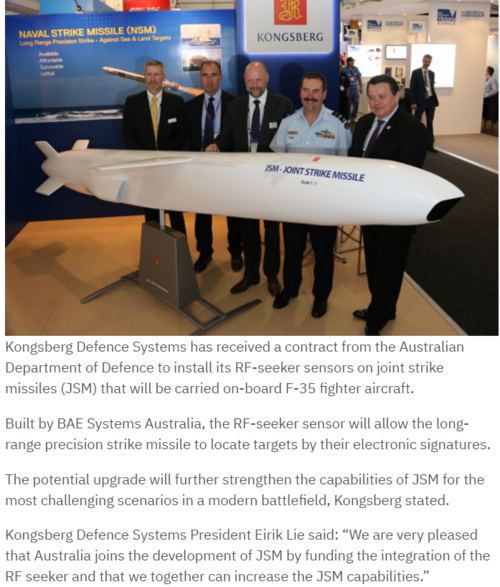
bring_it_on
I really should change my personal text
- Joined
- 4 July 2013
- Messages
- 3,231
- Reaction score
- 2,586
As I recall interim Siaw is basically AARGM-ER with different warhead , AARGM-ER and even AARGM can be used against ship already as far as I knowLRASM is a great capability. Besides the DARPA developed seeker (which folks just take for granted), its most important feature is that it is available and comes out of a hot production line that is guaranteed to stay in operation for the next decade if not longer. This allows investments to be made to the line to grow capacity in the future if they wanted to dramatically increase inventories. And roll in features into LRASM as they are introduced into the JASSM family more broadly. This saves time and money allowing both the USN and USAF to invest in other more demanding capability (ARRW, HAWC, Navy's hypersonic weapons, SiAW etc). In fact, if they did develop an anti-ship version of SiAW then it would be a perfect complement to the LRASM since it could be launched from closer to a target using the F-35 or other stealth aircraft.
SiAW is an Air Force program to field a multi-mission weapon that will counter the IADS threat. As an interim solution, the USAF is going to buy a modified version of the Navy's AARGM ER. The USAF still plans to compete the more enduring solution so we could end up with a different weapon if A) the AF picks a different proposal, or B ) If Northrop Grumman adds additional capability to its current SiAW offering. Difficult to see it not evolving into something a lot more different form the Navy AARGM-ER than what is currently planned (if not then why bother with a competition). But the idea of a Stand-In, high speed weapon that is IWB compatible is a good one especially for time-sensitive and well defended targets. The same can be purposed as a stand-in Anti-Ship weapon for the F-35, NGAD and B-21 by equipping it with an optimized warhead for that new role.
Attachments
bring_it_on
I really should change my personal text
- Joined
- 4 July 2013
- Messages
- 3,231
- Reaction score
- 2,586
Agree about NSM but JSM will also have a passive RF seeker
Yes but the devil as they say is in the details. It took DARPA a number of years to get the seeker on the LRASM ready and they are still upgrading the system to make it better. It remains to be seen whether any customer of the NSM or JSM makes a similar level of investment, or if technically they field a comparable solution. For one it is a smaller missile overall so packaging would likely be more difficult. But then it also has a much smaller warhead so perhaps that evens things out.
- Joined
- 9 October 2009
- Messages
- 21,085
- Reaction score
- 12,137
- Joined
- 21 April 2009
- Messages
- 13,549
- Reaction score
- 7,135
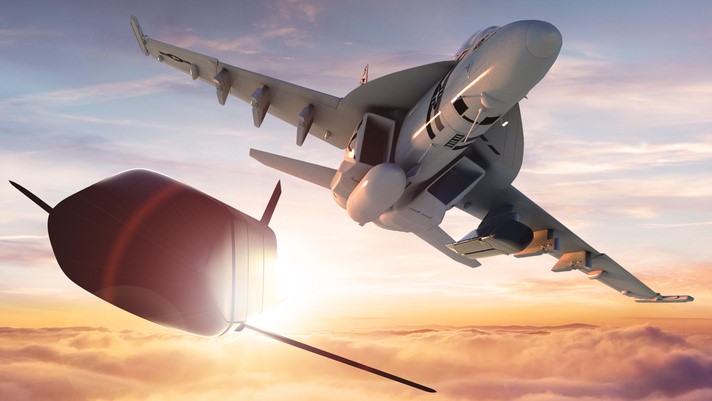
Next-generation Stealth Missile Seekers Improve Capability a
BAE Systems has received a $117 million contract to produce next-generation missile seekers for the Long Range Anti-Ship Missile (LRASM). BAE Systems has rec
newcomer22
ACCESS: Restricted
- Joined
- 4 June 2021
- Messages
- 7
- Reaction score
- 1
Could you say more about the novel passive guidance methods? I am trying to better understand the improvements made to missile guidance technology over the past decade or so!I think it is boring only in the sense it isn't supersonic. Its passive guidance methods are quite novel and combined with the low RCS airframe allow for an attack with very vague targeting information with a low probability of detection until the terminal sea skimming phase.
LRASM is supposed to be able to detect and geolocate radar emissions, and use that information to avoid air defenses and also identify targets.
View: https://www.youtube.com/watch?v=h449oIjg2kY
bring_it_on
I really should change my personal text
- Joined
- 4 July 2013
- Messages
- 3,231
- Reaction score
- 2,586
The BAE systems and DARPA developed passive RF seeker on the LRASM is what sets it apart from the JASSM-ER (also the networking). It is/was the main thrust behind the LRASM-A effort, otherwise this requirement could have simply been met by developing a longer ranged Harpoon.
newcomer22
ACCESS: Restricted
- Joined
- 4 June 2021
- Messages
- 7
- Reaction score
- 1
The BAE systems and DARPA developed passive RF seeker on the LRASM is what sets it apart from the JASSM-ER (also the networking). It is/was the main thrust behind the LRASM-A effort, otherwise this requirement could have simply been met by developing a longer ranged Harpoon.
What's new about the passive RF seeker?
bring_it_on
I really should change my personal text
- Joined
- 4 July 2013
- Messages
- 3,231
- Reaction score
- 2,586
What's new about the passive RF seeker?
The entire seeker is new. It didn't exist on JASSM-ER, or any other JASSM variant. One of the main thrusts of the program was developing the seeker itself.
DARPA just wanted an established off the shelf platform to work from so they didn't have to work on basics like propulsion, aerodynamics, and warhead. So they took the AGM-158 and started with that. This is why AGM-158C still uses the very sub optimal penetrating titanium warhead which is relatively low on explosive filler and could easily pass through an aircraft carrier to the other side. Something more semi armor piercing with more explosive (and ideally ziconium) would be more optimized for ship targets.
icyplanetnhc (Steve)
Trekking into the cosmic ocean
U.S. Navy Comes Full Circle On JASSM Program | Aviation Week Network
After several cancellations over decades, the Navy’s revived interest in the Joint Air-to-Surface Missile family also reveals pursuit of more capabilities for it.
I can’t quite find a dedicated AGM-158 thread, so I suppose this will have to do.
NASA
ACCESS: Restricted
- Joined
- 13 October 2020
- Messages
- 45
- Reaction score
- 111
For those who don't have access to it:
"An Aug. 18 U.S. Naval Air Systems Command (Navair) presolicitation notice referenced the “LRASM AGM-158C-2 Strike Capability” in the public domain for the first time. Navair responded to Aviation Week questions about 10 days later, confirming that the AGM-158C-2 is the U.S. Navy’s first air-launched, land-attack cruise missile since the Boeing AGM-84K Standoff Land Attack Missile-Extended Range entered service 21 years ago.
As name suggests, the AGM-158C-2 builds on the Long-Range Anti-Ship Missile (LRASM) program, which has fielded a maritime strike version of the U.S. Air Force’s AGM-158B Joint Air-to-Surface Missile-Extended Range (JASSM-ER) for the Navy’s Boeing F/A-18E/Fs and the Air Force’s Rockwell B-1Bs. The baseline AGM-158C LRASM adds a radio frequency sensor for homing in on moving targets at sea and a black, anti-corrosive coating to the JASSM-ER. The AGM-158C-2 is a naval version of the JASSM-ER, with no radio frequency terminal seeker, a Navair spokeswoman said. In fact, the presolicitation notice is the first confirmation of the Navy’s intent to follow through with a decision announced in the service’s fiscal 2022 budget request. The request revealed the Navy’s intent to buy the JASSM, likely as a replacement for the recent cancellation of a turbojet-powered version of the Raytheon AGM-154 Joint Standoff Weapon (JSOW).
The disclosure completes the Navy’s circuitous involvement in the JASSM program. An affordable, stealthy and extended-range cruise missile attractive to multiple services has been an elusive goal within the Defense Department for decades. In the mid-1990s, the Pentagon canceled the Northrop AGM-137 Tri-Service Standoff Attack Missile (TSSAM) sought by the Air Force, Navy and U.S. Army after projected unit costs nearly tripled.
The Air Force and Navy quickly launched the JASSM program in the late 1990s to replace the TSSAM, but the partnership did not last long. The Navy decided in 2004 to withdraw from the program with no direct replacement. Several years later, DARPA proved the viability of an anti-ship version of the JASSM under the Offensive Anti-Surface Warfare (OASuW) program. The Navy launched the development of the stealthy, subsonic OASuW Increment 1 in 2014, leading to the fielding of an early operational capability of LRASM five years later.
Cruise missiles of all kinds are enjoying widespread support from defense planners. The Pentagon alone plans to field the nuclear Long-Range Stand-Off for the Air Force and Sea-Launched Cruise Missile for the Navy, along with the conventional Hypersonic Attack Cruise Missile for the Air Force and the high-speed OASuW Increment 2 for the Navy within the next decade.
Indeed, the cruise missile’s popularity serves to obscure the detailed identity of the new AGM-158C-2. Navair’s description of the new weapon as a naval version of the JASSM-ER helps—but only to a point. The Air Force has fielded new versions of the JASSM-ER since it inducted the baseline in 2015. The AGM-158B-2 features a redesigned wing that enables the missile to achieve even longer range. Finally, the AGM-158D adds a weapons data link to the AGM-158B-2. It is not clear which version of JASSM-ER is the baseline for the Navy’s AGM-158C-2.
But the Navy’s revived interest in the JASSM family has revealed other capabilities. In detailed justification reports for the Navy’s fiscal 2022 budget, the service’s request for the $1.8 million AGM-158C-2 notes that the missile’s software will be converted to the C++ language. Job advertisements posted by Lockheed, meanwhile, describe an effort to recruit programmers to convert the software language for the JASSM family to C++ from Ada, an outdated language created by the Defense Department in the late 1980s. The switch to modern, widely accepted software language for JASSM opens the door to a vast multitude of capability upgrades. As the U.S. military experiments with containerized, inflight software updates for munitions and aircraft, software developers may find C++ code friendlier to the requirements’ Kubernetes orchestration tools than the Pentagon’s obsolete Ada"
"An Aug. 18 U.S. Naval Air Systems Command (Navair) presolicitation notice referenced the “LRASM AGM-158C-2 Strike Capability” in the public domain for the first time. Navair responded to Aviation Week questions about 10 days later, confirming that the AGM-158C-2 is the U.S. Navy’s first air-launched, land-attack cruise missile since the Boeing AGM-84K Standoff Land Attack Missile-Extended Range entered service 21 years ago.
As name suggests, the AGM-158C-2 builds on the Long-Range Anti-Ship Missile (LRASM) program, which has fielded a maritime strike version of the U.S. Air Force’s AGM-158B Joint Air-to-Surface Missile-Extended Range (JASSM-ER) for the Navy’s Boeing F/A-18E/Fs and the Air Force’s Rockwell B-1Bs. The baseline AGM-158C LRASM adds a radio frequency sensor for homing in on moving targets at sea and a black, anti-corrosive coating to the JASSM-ER. The AGM-158C-2 is a naval version of the JASSM-ER, with no radio frequency terminal seeker, a Navair spokeswoman said. In fact, the presolicitation notice is the first confirmation of the Navy’s intent to follow through with a decision announced in the service’s fiscal 2022 budget request. The request revealed the Navy’s intent to buy the JASSM, likely as a replacement for the recent cancellation of a turbojet-powered version of the Raytheon AGM-154 Joint Standoff Weapon (JSOW).
The disclosure completes the Navy’s circuitous involvement in the JASSM program. An affordable, stealthy and extended-range cruise missile attractive to multiple services has been an elusive goal within the Defense Department for decades. In the mid-1990s, the Pentagon canceled the Northrop AGM-137 Tri-Service Standoff Attack Missile (TSSAM) sought by the Air Force, Navy and U.S. Army after projected unit costs nearly tripled.
The Air Force and Navy quickly launched the JASSM program in the late 1990s to replace the TSSAM, but the partnership did not last long. The Navy decided in 2004 to withdraw from the program with no direct replacement. Several years later, DARPA proved the viability of an anti-ship version of the JASSM under the Offensive Anti-Surface Warfare (OASuW) program. The Navy launched the development of the stealthy, subsonic OASuW Increment 1 in 2014, leading to the fielding of an early operational capability of LRASM five years later.
Cruise missiles of all kinds are enjoying widespread support from defense planners. The Pentagon alone plans to field the nuclear Long-Range Stand-Off for the Air Force and Sea-Launched Cruise Missile for the Navy, along with the conventional Hypersonic Attack Cruise Missile for the Air Force and the high-speed OASuW Increment 2 for the Navy within the next decade.
Indeed, the cruise missile’s popularity serves to obscure the detailed identity of the new AGM-158C-2. Navair’s description of the new weapon as a naval version of the JASSM-ER helps—but only to a point. The Air Force has fielded new versions of the JASSM-ER since it inducted the baseline in 2015. The AGM-158B-2 features a redesigned wing that enables the missile to achieve even longer range. Finally, the AGM-158D adds a weapons data link to the AGM-158B-2. It is not clear which version of JASSM-ER is the baseline for the Navy’s AGM-158C-2.
But the Navy’s revived interest in the JASSM family has revealed other capabilities. In detailed justification reports for the Navy’s fiscal 2022 budget, the service’s request for the $1.8 million AGM-158C-2 notes that the missile’s software will be converted to the C++ language. Job advertisements posted by Lockheed, meanwhile, describe an effort to recruit programmers to convert the software language for the JASSM family to C++ from Ada, an outdated language created by the Defense Department in the late 1980s. The switch to modern, widely accepted software language for JASSM opens the door to a vast multitude of capability upgrades. As the U.S. military experiments with containerized, inflight software updates for munitions and aircraft, software developers may find C++ code friendlier to the requirements’ Kubernetes orchestration tools than the Pentagon’s obsolete Ada"

